Tehran Metro: Lines, Stations, and More (2024)
Tehran is a popular travel destination among tourists. Visitors are drawn to its famous landmarks, places, the grand Bazaar, parks, museums, and hospitable, friendly people.
While everyone loves visiting the city, the Tehran metro is a great way to travel quickly and cheaply throughout Tehran. However, when trying out the Tehran metro, it may seem a bit complicated at first with so many lines and stops, but once you get familiar with it and get the hang of it, you will see that using it is quite intuitive.
To make it easier for you to get around the Tehran Underground, in this guide, we will tell you everything you need to know about how it works, its timetables, the tickets available, how to buy them, and more. You will see how you will move around the Iran capital like a Tehrani!
Tehran Metro Map 2024
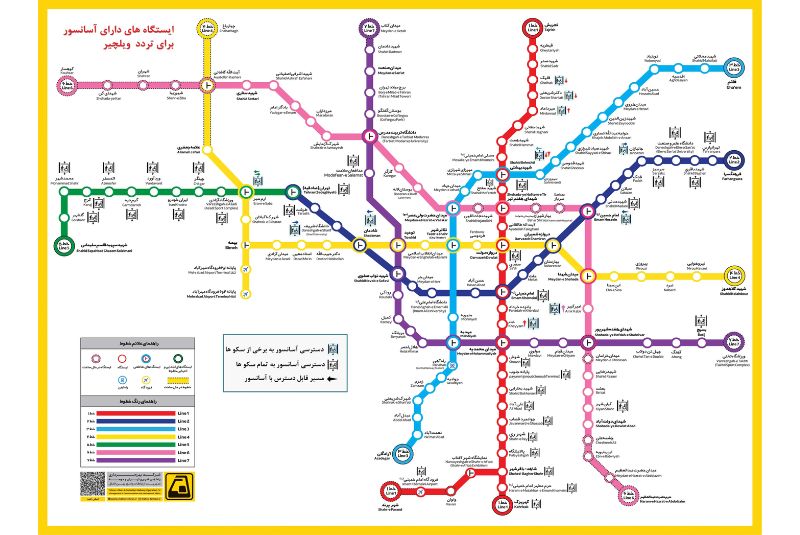
If you're planning to navigate the Tehran Metro, having access to the updated Tehran Metro map for 2024 can be incredibly helpful. While all trains have their own maps, there are a couple of reasons why these maps may not be suitable for you. Firstly, some trains may not have the latest Tehran Metro map installed yet. Secondly, you may want to ensure you have the most recent version of the map, which usually displays the date of the update.
To address these concerns, we provide you with a map of the Tehran Metro for 2024. This map will assist you in finding your way around the metro system and selecting the most convenient route to your desired destination. You can find the map below.
| Read more: Iran Travel Tips
Tehran Metro Lines
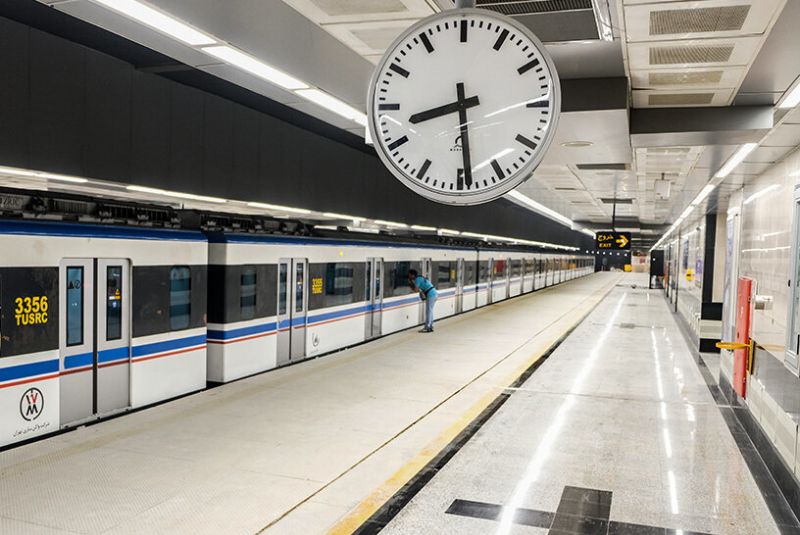
The metro lines in Tehran covered a total distance of 1,266 kilometers and featured 150 stations. Impressively, approximately 2.5 million passengers utilize the subway network daily, benefiting both the capital city and its suburbs.
The Tehran Metro is comprised of seven main lines, each serving a specific purpose. Lines two, three, four, six, and seven are entirely within the city, providing convenient transportation options for urban commuters. On the other hand, line five is an inter-city line that connects Tehran to Golshahr Karaj.
The first line of the Tehran Metro is unique as it starts as a suburban line but branches out near the terminal stations, extending towards Imam Khomeini Airport. Here are details about each of the metro lines including the stations and working hours.
| Discover: Are Iranians Tourist Friendly?
Line 1 (Red Line)
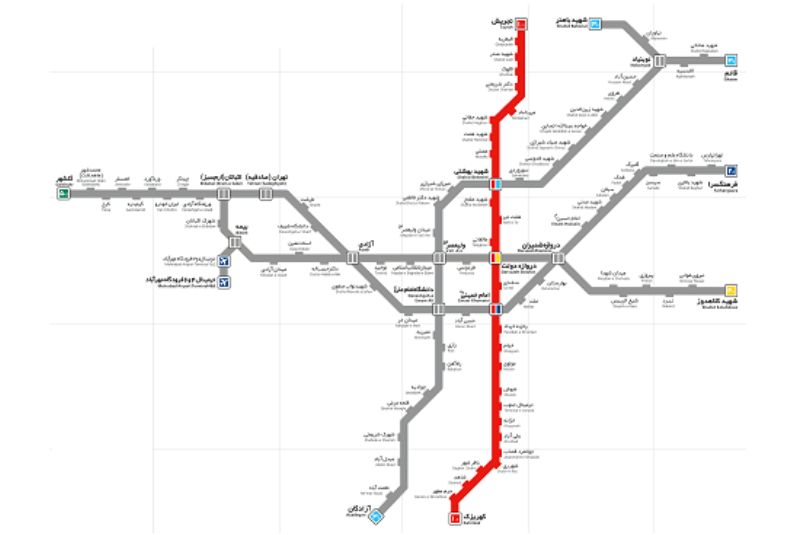
Tehran Metro Line 1 is depicted in red on the Tehran Metro map. It serves as a vital north-south connection within the city. Stretching across 42 kilometers, this line comprises 29 stations, commencing from Tajrish station and concluding at Kahrizak. The operational launch of the line dates back to 2001. Along its course, Line 1 intersects with six other lines, facilitating seamless transfers. Notably, on the route from Shahed-Baghershahr station, two stops before Kahrizak, there is a junction leading to Imam Khomeini Airport.
As of 2024, all 29 stations of Tehran Metro Line 1 are fully operational. However, there is another station named Tajrish Square, located near Tajrish Bazaar, which is currently in the construction phase. It is anticipated to be incorporated into the line in the future.
The Shahed-Baghershahr line, which connects to Imam Khomeini Airport, covers a distance of 30.4 kilometers and encompasses four stations. Additional stations, namely Vavan and Shahr-e-Parand, are currently under construction and will be incorporated into the Tehran airport metro route in due course. The Tehran metro stations along Line 1 include;
- Tajrish Square (under construction)
- Tajrish
- Qeytirye
- Shahid Sadr
- Golhak
- Shariati
- Mirdamad
- Shahid Haghani
- Shahid Hemmat
- Mosalla- ye Imam Khomeini (RA)
- Shahid Beheshti (intersects with Line 3)
- Shahid Mofatteh
- Shohada ye- Haftom-e Tir (intersects with Line 6)
- Taleghani
- Darvazeh Dowlat (intersects with Line 4)
- Sa’di
- Emam Khomeini (intersects with Line 2)
- Panzdah-e Khordad
- Khayyam
- Meydan Mohammadiyeh (intersects with Line 7)
- Shoush
- Jonoub (South) Terminal
- Shahid Bokharaei
- Ali Abad,
- Javanmard Ghassab
- Shahr-e Rey
- Palayeshgah
- Shahed - Bagher Shahr (branches to Imam Khomeini Airport and Shahr Parand), Imam Khomeini Haram( Shrine)
For the Imam Khomeini Airport route, the stations are as follows
- Shahed - Baghershahr
- Namayeshgah-e Shahr-e Aftab
- Vavan (under construction)
- Imam Khomeini Airport
- Shahr-e Parand (under construction)
| Read more: Visiting Iran as a Woman: Is It Safe?
Line 1 Working Hours
Tehran Metro Line 1 operates from 5:30 a.m. to 10:30 p.m., while the Imam Khomeini Airport line runs from 6:10 a.m. to 8:10 p.m.
Line 2 (Dark Blue Line)
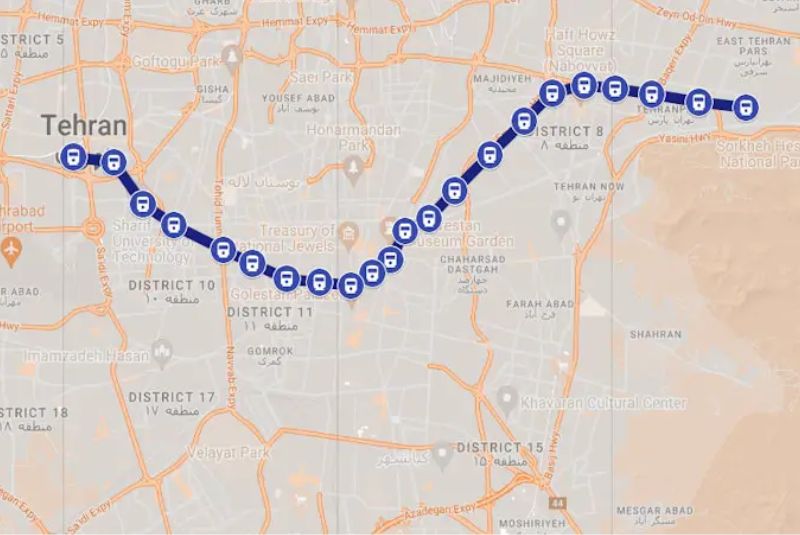
Tehran Metro Line 2 serves as a connection between the west and east parts of the capital city. This line is known as one of the oldest metro routes in the city and the busiest metro line in Tehran. It comprises 22 stations, with Sadeghieh Square being its westernmost station and also the starting point for the Tehran-Karaj metro route. This route spans a distance of 26.4 kilometers and intersects with five other metro lines at various stations.
All 22 stations along the line are fully operational, and its first station opened in 1999. On the Tehran Metro map, Line 2 is visually distinguished by a bold blue color. The stations along Line 2 include:
- Tehran, Sadeghieh (also the starting point for Line 5, Sadeghieh to Golshahr), Tarasht
- Sharif University
- Shademan (intersecting with Line 4)
- Shahid Navab Safavi (intersecting with Line 7)
- Meydan Horr Square
- Imam Ali University
- Hasan Abad
- Emam Khomeini (intersecting with Line 1)
- Mellat
- Baharestan
- Darvazeh Shemiran (intersecting with Line 4)
- Emam Hossein (intersecting with Line 6)
- Shahid Madani
- Sabalan
- Fadak
- Janbazan
- Sarsabz
- Elm-o San’at University
- Shahid Bagheri
- Tehranpars
Line 2 Working Hours
Line 2 operates from 5:30 a.m. to 10:30 p.m., and the entire journey typically takes around 45 minutes to complete.
| Suggestion: Traveling to Iran by Land - All You Need to Know
Line 3 (Light Blue Line)
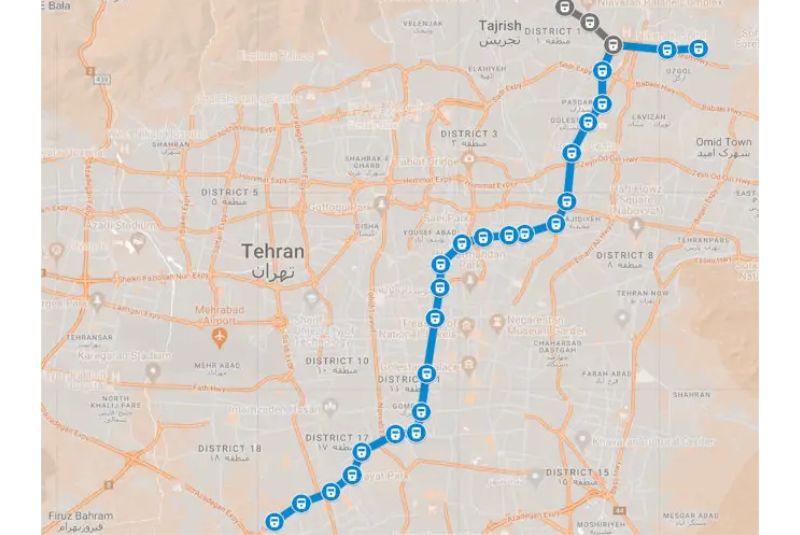
Tehran Metro Line 3 is depicted in pale blue on the metro map and extends from the northeastern to the southern parts of Tehran. It encompasses a total of 28 stations, with 25 stations currently in operation. This route spans a distance of 37 kilometers and intersects with other metro lines at four stations.
Line 3 commences at Ghaem station and concludes at Azadegan station. During the design phase of Line 3, two stations were designated as the starting points at the northern end of the route.
One route initiates from Ghaem station, while the other commences from Bahonar station, and both converge at Nobonyad station. However, Shahid Bahonar and Niavaran stations are still in the design phase and are yet to be incorporated into the line. The first stations of Line 3 were inaugurated in 2012. The stations along Line 3 include:
- Shahid Bahonar (in the construction stage)
- Niavaran Park (under construction)
- Ghaem
- Shahid Mahallati
- Aghdasiyeh
- Nobonyad
- Hossein Abad
- Meydan-e Heravi
- Shahid Zeynoddin
- Khajeh Abdollah Ansari
- Shahid Sayyad Shirazi
- Shahid Ghodousi
- Sohrevardi
- Shahid Beheshti (intersecting with Line 1)
- Mirza-ye Shirazi
- Meydan-e Jahad
- Meydan Hazrat-e Vali (Intersecting with line 6)
- City Theater (intersecting with Line 4)
- Valiasr Avenue (under construction, intersecting with Line 2)
- Moniriyeh
- Mahdieh (intersecting with Line 7)
- Rahahan
- Javadiyeh
- Zamzam
- Shahrake Shariati
- Abdol Abad
- Ne’imat Abad
Line 3 Working Hours
The operating hours of Tehran Metro Line 3 are from 5:30 a.m. to 10:30 p.m., and the entire journey along the route typically takes around one hour to complete.
| Also read about: Social Media in Iran - Accessing & Staying Connected
Line 4 (Yellow Line)
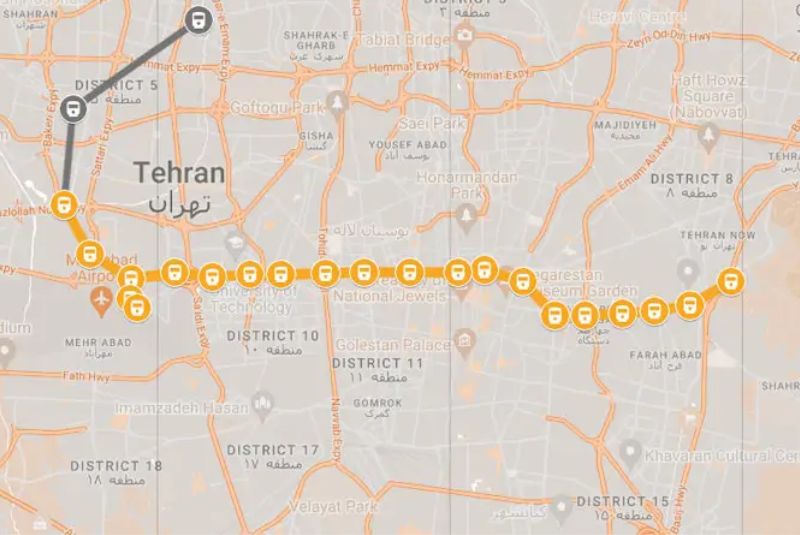
Tehran Metro Line 4 is represented by the color yellow on the metro map and operates in an East-West direction. The initial sections of this line commenced operations in 2008. It is characterized by two remaining stops before reaching the end of the route and features a split leading to the terminals of Mehrabad Airport at two stations.
Line 4 intersects with other metro lines at seven stations and ultimately reaches Allameh Jafari station.
The main line of line 4 spans 22 kilometers, with an additional 2 kilometers on the branch line to Mehrabad Airport. The line comprises a total of 22 stations, of which 20 are currently active. Two stations are currently under construction, serving the future access to Ferdows Blvd West, Ayatollah Kashani, and Chahar Bagh Jannat Abad Square. The stations along Line 4 include:
- Shahid Kolahdooz
- Nirou Havaei
- Nabard
- Pirouzi
- Ebn Sina
- Meydan Shohada (intersecting with Line 6)
- Darvazeh Shemiran (intersecting with Line 2)
- Darvazeh Dowlat (intersecting with Line 1)
- Ferdowsi Square
- City Theater (intersecting with Line 3)
- Meydan-e Enghelab-e Eslami
- Towhid (intersecting with Line 7)
- Shademan (intersecting with Line 2)
- Doctor Habibollah
- Ostad Moein
- Meydan (Azadi Square)
- Bimeh (branch to Mehrabad Airport)
- Shahrak-e Ekbatan
- Eram-e Sabz (junction with Line 5)
- Allameh Jafari
- Ayatollah Kashani (under Construction)
- Chaharbagh (under construction)
The branch from the Bimeh station leads to the following destinations in Mehrabad Airport:
- Mehrabad Airport Terminals 1 and 2
- Mehrabad Airport Terminals 4 and 6
Line 4 Working Hours
A trip along Tehran Metro Line 4 takes approximately 50 minutes. The line operates from 5:30 a.m. to 10:30 p.m., while the section to the airport operates from 5:37 a.m. to 10:30 p.m.
| Suggestion: Iran Travel Costs - A Budget-Friendly Guide
Line 5 (Green Line)
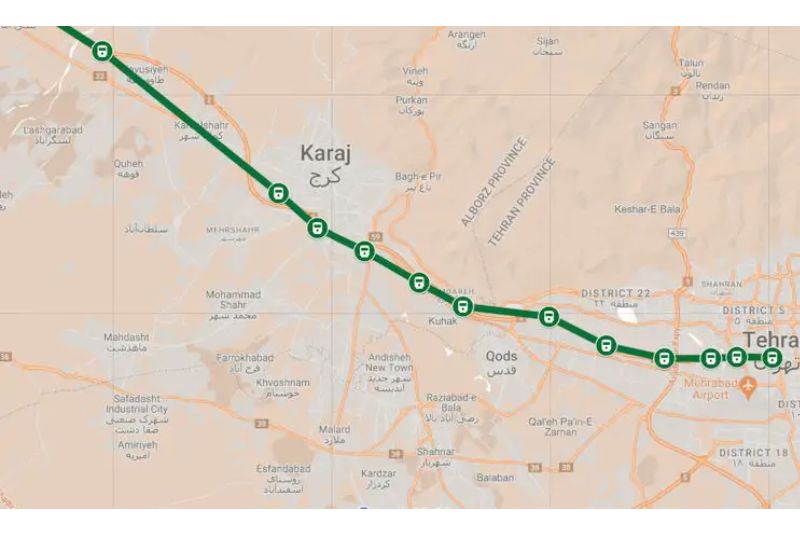
Tehran Metro Line 5 stretches from Sadeghieh in western Tehran to Shahid Sepehbod Ghasem Soleimni. It covers a distance of 67 km with 12 stations. The line was introduced in 1998.
It is marked in green on the map and features both regular and high-speed trains. High-speed trains make limited stops, exclusively halting at Sadeghiyeh, Eram Sabz, Karaj, and Golshahr stations. Travel time between Sadeghieh and Golshahr is approximately 50 minutes, while the journey to Karaj Station takes 30 minutes and 40 minutes to Golshahr Station. The stations along Line 5 include:
- Hashtgerd
- Golshahr
- Mohammad Shahr
- Karaj
- Atmosfer
- Garmdarreh
- Vardavard
- Iran Khodro
- Chitgar
- Azadi Sport Complex
- Eram Sabz (intersecting with Line 4)
- Sadeghieh, Tehran (intersecting with Line 2)
Line 5 Working Hours
Line 5 operates from 5 am to 10:30 pm on the Sadeghieh-Golshahr route and from 8 am to 3:40 pm on the Golshahr-Shahid Sepehbod Ghasem Soleimni(also known as Hashtgerd) route.
| Read more: Most Common Farsi Phrases for Tourists in Iran
Line 6 (Pink Line)
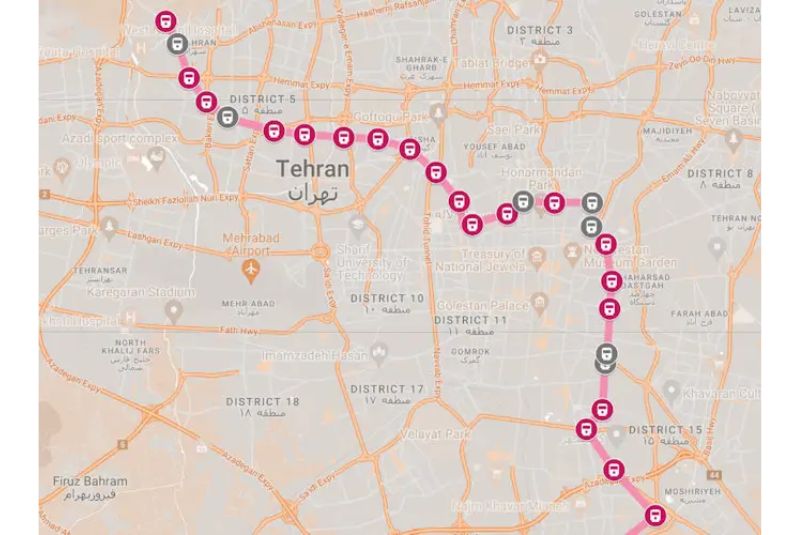
The Pink Line is a significant transportation route in Tehran, connecting the northwestern area of the city to the southeast. The line was opened in 2017 and spans a length of 31 kilometers and is marked with the color pink on the metro map.
Currently, 11 out of the total 31 stations are operational. The line is divided into two phases: the eastern phase runs between Meydan Valiasr and Shahid Sattari stations, while the western phase extends from Shohada-ye Dowlat Abad to Meydan Valiasr. Stations along Tehran Metro Line 6 include:
- Kouhsar (under construction),
- Shohada-ye Kan (under construction)
- Shahran (under construction)
- Shahr-e Ziba (under construction)
- Ayatollah Kashani (under construction)
- Shahid Sattari
- Shahid Ashrafi Esfahani
- Yadegar Imam
- Marzdaran
- Shahrak-e Azmayesh
- Tarbiat Modarres University,
- Karegar (under construction)
- Laleh Park
- Meydan Valiasr (intersecting with Line 3)
- Shahid Nejatollahi (under construction)
- Shohada-ye Haftom-e Tir (intersecting with Line 1)
- Bahar Shiraz (under construction)
- Sarbaz (under construction)
- Emam Hossein (intersecting with Line 2)
- Meydan Shohada (intersecting with Line 4),
- Amir Kabir
- Shohada-ye Hefdah-e Sharivar (intersecting with line 7)
- Meydan Khorasan (under construction),
- Shahid Rezaei,
- Be’sat
- Kiyan Shahr
- Shohada-ye Dowlat Abad
- Cheshmeh Ali (under construction),
- Ebn Babviyeh (under construction),
- Meydan-e Hazrat-e Abdolazim (under construction),
- Haram-e Hazrat Abdolazim (under construction).
Line 6 Working Hours
The journey on Line 6 takes approximately 20 minutes, and the operating hours are from 5:30 am to 10:30 pm.
| Suggestion: Things to Bring Back From Iran
Line 7 (Purple Line)
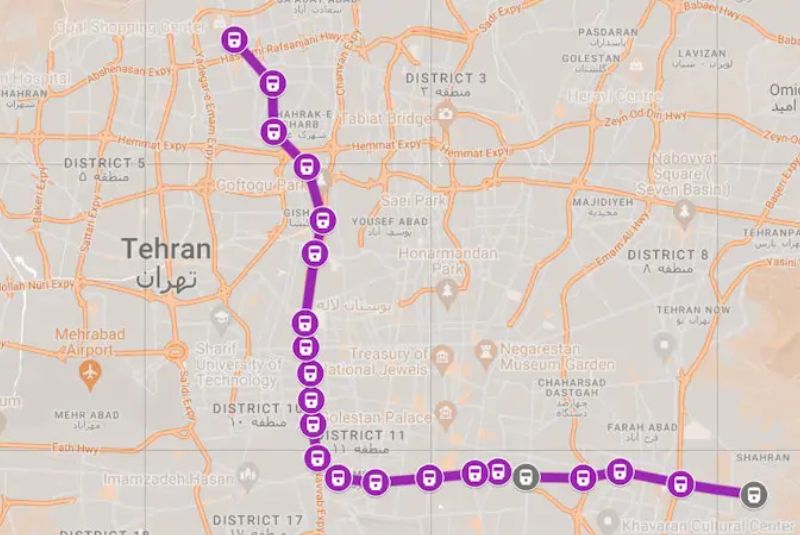
Tehran Metro Line 7 is characterized by its purple color on the metro map. The line consists of 22 stations, with 19 of them currently operational. The line 7 had its initial opening in early 2017 and it intersects with other metro lines at five stations. The total length of the line is nearly 27 km, with approximately 20 km currently in use. Stations along Tehran Metro Line 7 include:
- Meydan-e Kitab (under construction)
- Shahid Dadman
- Meydan-e San’at
- Tehran Milad Tower
- Goftegou Park
- Tarbiat Modares University (intersecting with Line 6)
- Modafean-e Salamat
- Towhid (intersecting with line 4)
- Shahid Navab Safavi (intersecting with Line 2)
- Roudaki
- Komeyl
- Beryanak
- Helal Ahmar
- Mahdiyeh (intersecting with Line 3)
- Meydan Mohammadiyeh (intersecting with Line 1)
- Mowlavi
- Meydan Ghiyam
- Shohada-ye Hefdah-e Shahrivar (under construction)
- Chehel Tan-e Doulab
- Ahang
- Basij
- Varzeshgah e-Takhti (under construction)
Line 7 Working Hours
A trip on Line 7 takes approximately 35 minutes, and the line operates from 5:30 am to 10:30 pm, aligning with the schedule of other Tehran Metro lines.
| Discover: Can I Travel to Iran from USA?
Types of Metro Tickets and How to Pay for Tehran Metro
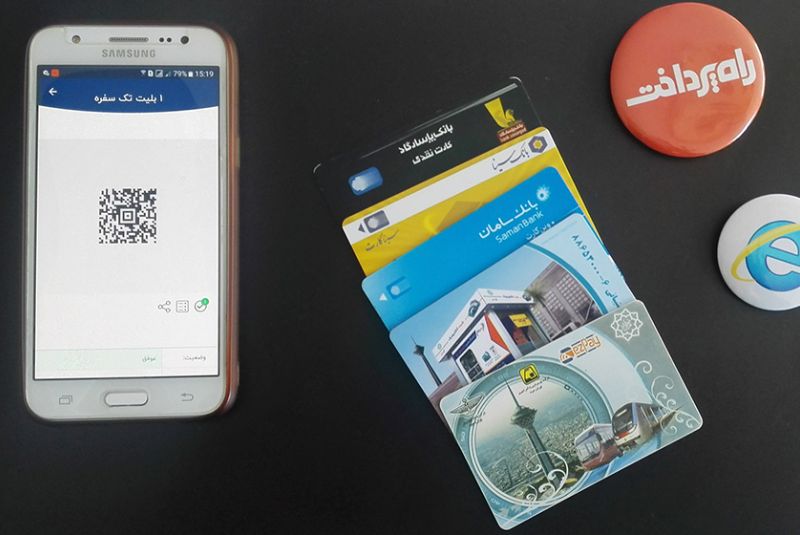
When it comes to paying for the Tehran Metro, several options are available to passengers. In the early days of the metro, paper cards were used, which allowed passengers to travel throughout the network until they exited the subway. Later, magnetic tickets were introduced, available in single or two-trip formats, providing convenience for daily commuters.
In recent years, the introduction of smart cards revolutionized the payment system. These rechargeable cards require users to tap them on designated gates to access the subway.
Smart cards can be easily recharged, and a portion of the balance is deducted after each use. These cards are versatile, as they can also be used on inner-city buses and BRT lines. Additionally, easy-pay metro cards have emerged as smaller alternatives to smart cards, offering similar functionalities.
To recharge the smart cards or easy pay, passengers can seek assistance from metro staff or utilize the smart card recharging machines available within the subway. QR-code tickets, obtained from POS machines, are also prevalent within the metro. These paper tickets are easily obtainable, although currently, only one type is available.
Before boarding the metro, passengers must acquire a smart card, easypay, or QR-code ticket. For daily commuters, smart cards are recommended. It's important to note that smart cards and easypay tickets are available for purchase at subway kiosks, and although they are sold separately, they can be recharged with any desired amount.
| Discover: Can I Travel to Iran from UK?
Tehran Metro Mobile App
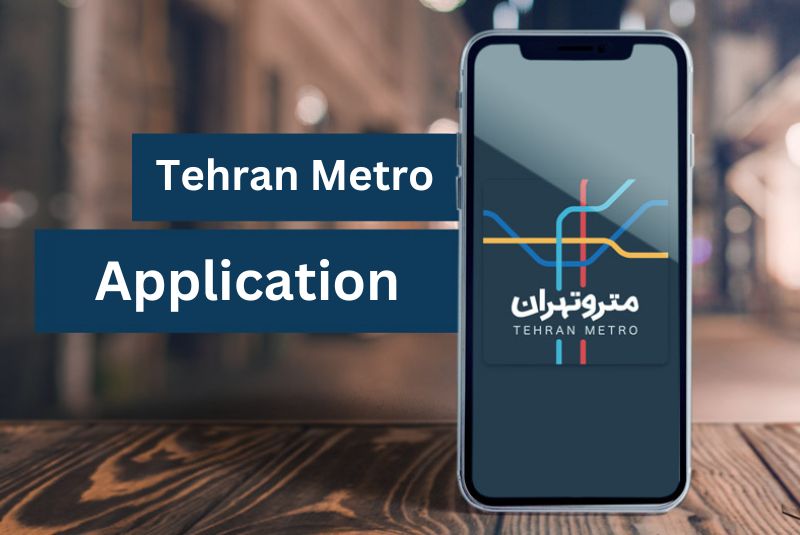
One of the most important travel management tools in Tehran is an app known as the Tehran Metro App. It is an interesting application that shows the map of the metro and the GPS positioning of each train. It also shows the time of departure and the arrival time of each train to different stations. So if you are planning to travel by metro in Tehran and do not know the way, the best tool to guide you is this Tehran Metro app.
| Read more: Iran Tours for U.S. citizens
Tehran Metro Ticket Price
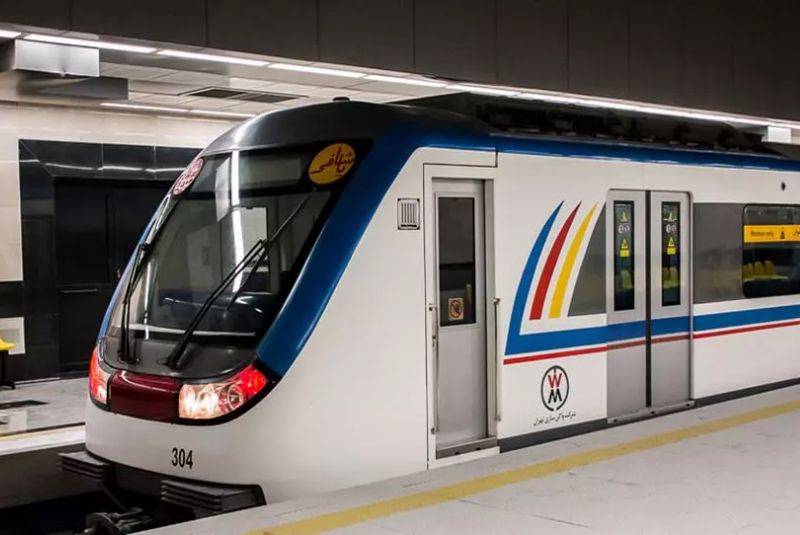
The Tehran Metro ticket prices range from a minimum of 2,500 tomans to a maximum of 3,770 tomans, depending on the route.
Special discounts are available for passengers using metro cards and online tickets to promote the use of electronic tickets, which reduces paper consumption. Elderly passengers can benefit from dignity cards, which offer significant discounts to facilitate their metro travel. Additionally, there are specific times, such as the start of the school year, when the use of the Tehran Metro is free for symbolic purposes.
It is important to note that when entering the subway, only the minimum fare is deducted from your card. Upon exiting and presenting the card at the exit gate, the remaining fare is deducted based on the distance traveled. Failure to provide a ticket at the exit gate will result in the deduction of the maximum ticket price from your card.
| Also might be interesting: Iranian's Customs and Traditions - Fun to Know or Essential?
Bottom Line
If you have experience living in a metropolis, you will know that using the metro greatly saves time and money on transportation. We have provided you with a comprehensive guide to the Tehran metro including Tehran metro stations, updated Tehran metro map, ticket prices, and working hours. So, with your rechargeable metro card in your pocket and our Tehran metro map guide on your phone, you can go ahead and use this huge network.
Share your story!
Comment below and let us know about your Experience.
Your story inspires others!


Comment
Leave a Comment